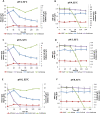Bioethanol production from Ficus fruits (Ficus cunia) by Fusarium oxysporum through consolidated bioprocessing system
- PMID: 35865259
- PMCID: PMC9294110
- DOI: 10.1007/s13205-022-03234-y
Bioethanol production from Ficus fruits (Ficus cunia) by Fusarium oxysporum through consolidated bioprocessing system
Abstract
Fusarium oxysporum is among the few filamentous fungi capable of fermenting ethanol directly from lignocellulose biomass (LCB). It has the essential enzymatic toolbox to disintegrate LCB to its monosaccharides, which subsequently fermented to ethanol under anaerobic and micro-aerobic conditions. However, the structural complexity of LCB and modest performances of wild fungi are major limitations for application in local biorefineries. This study assessed the potential of the locally isolated Fusarium oxysporum for the production of bioethanol from Ficus fruits (Ficus cunia) using Consolidated Bioprocessing (CBP). The maximum ethanol concentration achieved was at 5% substrate loadings with pH 6 irrespective of temperature variance, attaining a concentration of 3.54 g/L and 3.88 g/L at 28 °C and 32 °C, respectively. The monitoring of analytes (glucose, arabinose, cellobiose, xylose, acetic acid, ethanol, furfural, and HMF) in this study suggests the utilization of an array of sugars released from Ficus fruits, irrespective of the difference in the process parameters. This study also shows that CBP of freshly grounded Ficus fruits was feasible employing a mild hydrothermal pretreatment (autoclaved at 121 °C for 30 min in 1:10 w/v) and without supplementing any extraneous enzymes.
Supplementary information: The online version contains supplementary material available at 10.1007/s13205-022-03234-y.
Keywords: Consolidated bioprocessing: waste; Enzymes; Ethanol; Fusarium oxysporum.
© King Abdulaziz City for Science and Technology 2022.
Conflict of interest statement
Conflicts of interest/Competing interestsThe authors have no conflicts of interest
Figures



Similar articles
-
Fungal-mediated consolidated bioprocessing: the potential of Fusarium oxysporum for the lignocellulosic ethanol industry.AMB Express. 2016 Mar;6(1):13. doi: 10.1186/s13568-016-0185-0. Epub 2016 Feb 18. AMB Express. 2016. PMID: 26888202 Free PMC article.
-
Metabolic Engineering of Fusarium oxysporum to Improve Its Ethanol-Producing Capability.Front Microbiol. 2016 May 4;7:632. doi: 10.3389/fmicb.2016.00632. eCollection 2016. Front Microbiol. 2016. PMID: 27199958 Free PMC article.
-
Consolidated bioethanol production from olive mill waste: Wood-decay fungi from central Morocco as promising decomposition and fermentation biocatalysts.Biotechnol Rep (Amst). 2020 Oct 9;28:e00541. doi: 10.1016/j.btre.2020.e00541. eCollection 2020 Dec. Biotechnol Rep (Amst). 2020. PMID: 33102160 Free PMC article.
-
Perspectives and new directions for the production of bioethanol using consolidated bioprocessing of lignocellulose.Curr Opin Biotechnol. 2009 Jun;20(3):364-71. doi: 10.1016/j.copbio.2009.05.006. Epub 2009 Jun 10. Curr Opin Biotechnol. 2009. PMID: 19520566 Review.
-
Fusarium oxysporum: status in bioethanol production.Crit Rev Biotechnol. 1991;11(2):129-47. doi: 10.3109/07388559109040619. Crit Rev Biotechnol. 1991. PMID: 1913845 Review.
Cited by
-
Fungal bioprocessing for circular bioeconomy: Exploring lignocellulosic waste valorization.Mycology. 2024 Mar 18;15(4):538-563. doi: 10.1080/21501203.2024.2316824. eCollection 2024. Mycology. 2024. PMID: 39678640 Free PMC article. Review.
-
Filamentous fungi for sustainable remediation of pharmaceutical compounds, heavy metal and oil hydrocarbons.Front Bioeng Biotechnol. 2023 Feb 14;11:1106973. doi: 10.3389/fbioe.2023.1106973. eCollection 2023. Front Bioeng Biotechnol. 2023. PMID: 36865030 Free PMC article. Review.
References
-
- Ahmed B, Aboudi K, Tyagi VK, José Álvarez Gallego C, Fernández-Güelfo LA, Romero-García LI, Kazmi AA. Improvement of anaerobic digestion of lignocellulosic biomass by hydrothermal pretreatment. Appl Sci. 2019;9(18):3853. doi: 10.3390/app9183853. - DOI
-
- Antizar-Ladislao B, Turrion-Gomez JL. Second-generation biofuels and local bioenergy systems, Biofuels. Bioprod Biorefin. 2008;2:455–469. doi: 10.1002/bbb. - DOI
LinkOut - more resources
Full Text Sources

